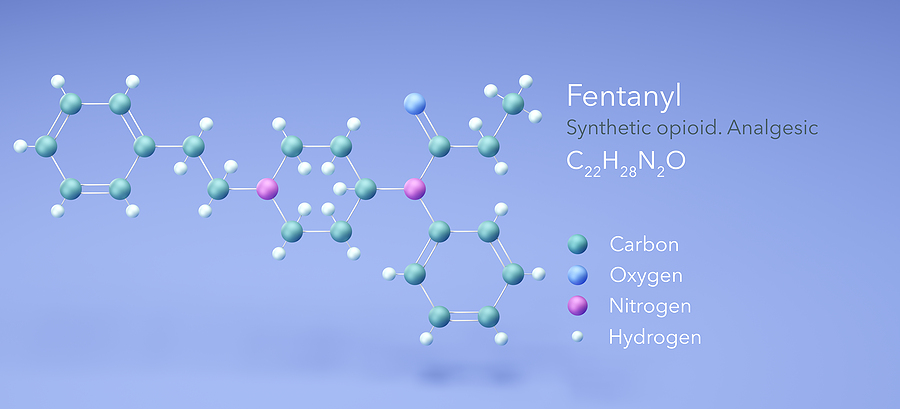
Fentanyl
Have a conversation with students or your children.
Simply telling teens to not do drugs is not the most effective way to discuss fentanyl and other opioid drug risks. The teens that are the most at risk may just tune this warning out if they feel like they’re being judged. Focus the conversation on scientific facts and life-saving information. Listen and use the D.A.R.E. decision making model as a guide.
How bad is the opioid epidemic and deaths from fentanyl?
According to the Centers for Disease Control & Prevention (CDC), 107,375 people in the United States died of drug overdoses and drug poisonings in the 12-month period ending in January 2022. A staggering 67 percent of those deaths involved synthetic opioids like fentanyl. Some of these deaths were attributed to fentanyl mixed with other illicit drugs like cocaine, methamphetamine, and heroin, with many users unaware they were actually taking fentanyl.
How big is the risk from fentanyl?
Fentanyl is tasteless, odorless, and too small to see. In fact, an amount about the size of two grains of salt can cause an overdose or death. The only “safe” use is when taken under a physician’s prescription, supervision, and strict directions for treatment of pain associated with a disease or injury. Street drugs are frequently laced with fentanyl long before they reach the friends, dealers, and friends-of-friends teens trust to supply them. Fentanyl can be anywhere, as distribution in pills and powders is totally random. While one pill might not be deadly, another one could be.
Drug traffickers are using fake pills to exploit the opioid crisis and prescription drug misuse.
Fentanyl, the synthetic opioid most commonly found in counterfeit pills, is the primary driver in this alarming increase in overdose deaths. DEA officials report a dramatic rise in the number of counterfeit pills containing at least 2 mg of fentanyl, which is considered a deadly dose. Testing at the DEA lab has shown 4 of every 10 illicitly manufactured pills to contain a potentially lethal dose of fentanyl.
What is fentanyl?
There are two types of fentanyl: pharmaceutical fentanyl and illicitly manufactured fentanyl. Both are considered synthetic opioids. Pharmaceutical fentanyl is prescribed by doctors to treat severe pain, especially after surgery and for advanced-stage cancer. However, most recent cases of fentanyl related overdose are linked to illicitly manufactured fentanyl, which is distributed through illegal drug markets for its heroin-like effect. It is often added to other drugs because of its extreme potency, which makes drugs cheaper, more powerful, more addictive, and more dangerous.
Fentanyl is a Schedule II narcotic under the United States Controlled Substances Act of 1970. Fentanyl is more potent than other opioids, it is 50 times stronger than heroin and 100 times stronger than morphine.
Drug dealers often sell fentanyl as fake oxycodone. Buyers may think they’re getting oxycodone, but they’re getting another opioid drug that has fentanyl and other substances in it. On the street, these drugs have nicknames like:
- Beans
- Green apples
- Apples
- Shady eighties
- Eighties
- Fake oxy
- Apache
- Goodfellas
- Great Bear
- He-Man
- Jackpot
- King Ivory
- Murder 8
- Tango & Cash
- China Girl
- China Town
- Dance Fever
- Greenies
Parents should be alert to their children using these terms in conversation.
What is the effect on the body?
Fentanyl, similar to other opioid analgesics (e.g., morphine), produces effects such as relaxation, euphoria, pain relief, sedation, confusion, drowsiness, dizziness, nausea, vomiting, urinary retention, pupillary constriction, and respiratory depression.
Why do people take fentanyl?
Licensed medical doctors prescribe fentanyl to people who suffer from severe pain (e.g. from cancer) that other medicine has not been able to help with. Others may use it to get high or to help with sleep. As with all prescriptions for medicines, physicians take into consideration many variables for the concerned patient.
How is fentanyl different from oxycodone and other opioids?
Fentanyl is significantly stronger than oxycodone and many other opioids. When fentanyl is taken by mouth or by intravenous (IV) injection, it has a stronger effect than most other opioids.
What is illicitly manufactured fentanyl?
Illicitly manufactured fentanyl (IMF) is available on the drug market in different forms, including liquid and powder1.
Powdered fentanyl looks just like many other drugs. It is commonly mixed with drugs like heroin, cocaine, and methamphetamine and made into pills that are made to resemble other prescription opioids. Fentanyl-laced drugs are extremely dangerous, and many people may be unaware that their drugs are laced with fentanyl. In its liquid form, IMF can be found in nasal sprays, eye drops, and dropped onto paper or small candies.
Can using fentanyl poison me?
Yes…moreover, it can kill you with only an extremely small dosage.
What are the overdose effects?
Overdose may result in stupor, changes in pupillary size, cold and clammy skin, cyanosis, coma, and respiratory failure leading to death. The presence of triad of symptoms such as coma, pinpoint pupils, and respiratory depression are strongly suggestive of opioid poisoning.
Is fentanyl addictive?
Yes, fentanyl can be addictive. With frequent use, you may develop a tolerance and need more and more to feel the same effects. Further, an individual can become mentally and physically dependent on fentanyl.
Since naloxone is an antidote to a fentanyl overdose, isn’t there really no risk to its use?
Naloxone can reverse symptoms of fentanyl and other opioid poisoning. However, it doesn’t work every time and the effects of the naloxone may not last as long as the opioid. Fentanyl is safe only when it’s prescribed and supervised by a doctor, obtained at a licensed pharmacy, and taken as directed. Fentanyl that’s made illegally has an unknown amount of fentanyl and may contain other substances like cocaine, heroin, and xylazine (a drug given to animals to help with pain), which put users at even higher risk of being poisoned or death.
What are the signs of overdose?
Recognizing the signs of opioid overdose can save a life. Here are some things to look for:
- Small, constricted “pinpoint pupils”
- Unresponsive, falling asleep or losing consciousness
- Slow, weak, or no breathing
- Choking or gurgling sounds
- Limp body
- Cold and/or clammy skin
- Discolored skin (especially in lips and nails)
What should I do if I see someone who is poisoned from fentanyl?
Call 911 as soon as possible if the person becomes unconscious, stops breathing, has chest pain, or has a seizure. Start CPR right away if the person stops breathing or has no pulse. Take any remaining pills from the person’s mouth or patches from his or her skin so the person doesn’t absorb any more fentanyl. If you have naloxone, give it to the person as soon as possible. Try to keep the person awake and breathing. Lay the person on their side to prevent choking.
What if I have taken or been exposed to fentanyl and I think I have fentanyl poisoning?
Call 911 right away if you may have fentanyl poisoning. Don’t take any more pills. If you’re wearing fentanyl transdermal patches, take them off so you don’t absorb any more fentanyl.
